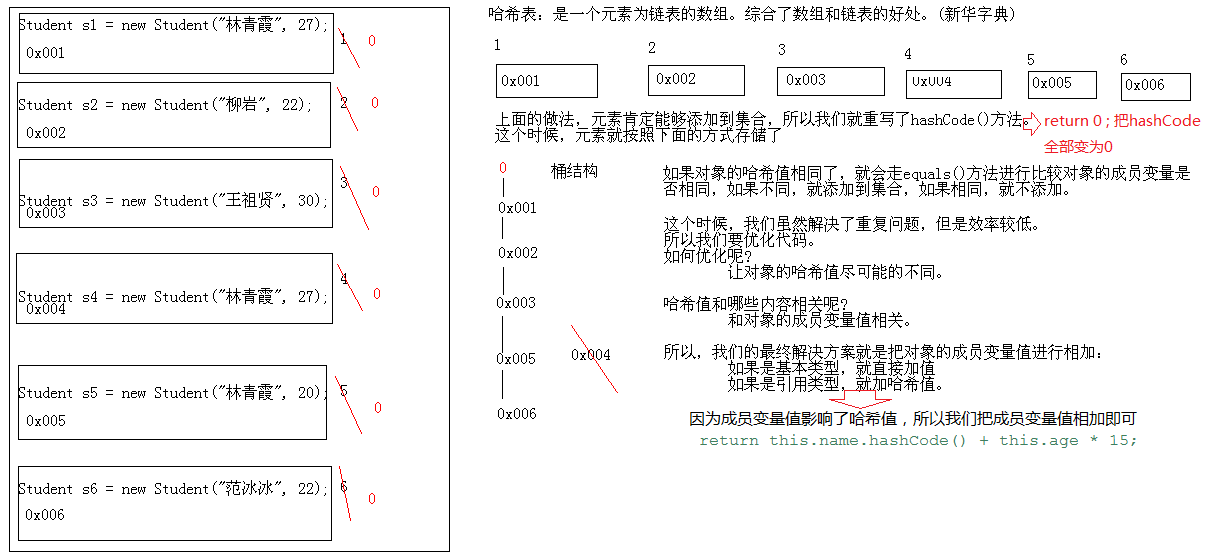当我们想要创建一个集合,该集合里面的元素都具有唯一性时。会遇到两种情况:
A:元素为String类型,可以直接用Hashset<String>集合来创建
String类重写了hashCode()和equals()方法,所以,它就可以把内容相同的字符串去掉。只留下一个。
B:当元素为自定义对象的时候,那么,就要在这个对象的类中重写hashCode()和equals()方法
下图是思路:

其实,扯了这么多,上面那些只要理解思路就行了。。。这玩意不用自己写
在类上面 Alt+Shift+s ,再点h,就能生成相对应的重写的hashCode()和equls()方法了
代码体现:
首先创建一个对象类:
1 package zl_HashCode; 2 3 public class Animal { 4 5 private String name; 6 private String color; 7 private int age; 8 public Animal() { 9 super(); 10 // TODO Auto-generated constructor stub 11 } 12 public Animal(String name, String color, int age) { 13 super(); 14 this.name = name; 15 this.color = color; 16 this.age = age; 17 } 18 public String getName() { 19 return name; 20 } 21 public void setName(String name) { 22 this.name = name; 23 } 24 public String getColor() { 25 return color; 26 } 27 public void setColor(String color) { 28 this.color = color; 29 } 30 public int getAge() { 31 return age; 32 } 33 public void setAge(int age) { 34 this.age = age; 35 } 36 @Override 37 public int hashCode() { 38 final int prime = 31; 39 int result = 1; 40 result = prime * result + age; 41 result = prime * result + ((color == null) ? 0 : color.hashCode()); 42 result = prime * result + ((name == null) ? 0 : name.hashCode()); 43 return result; 44 } 45 @Override 46 public boolean equals(Object obj) { 47 if (this == obj) 48 return true; 49 if (obj == null) 50 return false; 51 if (getClass() != obj.getClass()) 52 return false; 53 Animal other = (Animal) obj; 54 if (age != other.age) 55 return false; 56 if (color == null) { 57 if (other.color != null) 58 return false; 59 } else if (!color.equals(other.color)) 60 return false; 61 if (name == null) { 62 if (other.name != null) 63 return false; 64 } else if (!name.equals(other.name)) 65 return false; 66 return true; 67 } 68 69 70 }
具体测试类:
1 package zl_HashCode; 2 /* 3 HashSet集合存储自定义对象并遍历。如果对象的成员变量值相同即为同一个对象 4 5 注意了: 6 你使用的是HashSet集合,这个集合的底层是哈希表结构。 7 而哈希表结构底层依赖:hashCode()和equals()方法。 8 如果你认为对象的成员变量值相同即为同一个对象的话,你就应该重写这两个方法。 9 如何重写呢?不同担心,自动生成即可。 10 */ 11 import java.util.HashSet; 12 13 public class HashCodeTest1 { 14 15 public static void main(String[] args) { 16 17 HashSet<String> hs = new HashSet<String>(); 18 //首先导入String类型的元素,看效果 19 hs.add("阿猫"); 20 hs.add("阿狗"); 21 hs.add("花花"); 22 hs.add("阿猫"); 23 hs.add("阿狗"); 24 hs.add("草草"); 25 //遍历集合1 26 for(String s1 : hs){ 27 //HashSet集合中存储String类型,元素会唯一性 28 System.out.println(s1);//花花草草阿狗阿猫 29 } 30 31 HashSet<Animal> ha = new HashSet<Animal>(); 32 33 //再创建自定义对象的元素并导入 34 Animal a1 = new Animal("荷兰猪","粉白",2); 35 Animal a2 = new Animal("泰迪犬","棕色",1); 36 Animal a3 = new Animal("哈士奇","白色",3); 37 Animal a4 = new Animal("荷兰猪","粉白",2); 38 Animal a5 = new Animal("泰迪犬","棕色",2); 39 Animal a6 = new Animal("荷兰猪","黑白",2); 40 41 ha.add(a1); 42 ha.add(a2); 43 ha.add(a3); 44 ha.add(a4); 45 ha.add(a5); 46 ha.add(a6); 47 48 for(Animal a : ha){ 49 System.out.println(a.getName()+" "+a.getColor()+" "+a.getAge()); 50 /* 对象类中重写了hashCode()和equals()方法,只让存储进唯一元素 51 若是不重写,则由于每个自定义对象的hashCode值不一样,所以都能存储进去 52 泰迪犬 棕色 1 53 泰迪犬 棕色 2 54 荷兰猪 粉白 2 55 哈士奇 白色 3 56 荷兰猪 黑白 2 57 */ 58 } 59 } 60 61 }